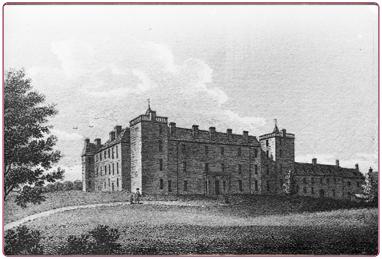Random Palace jottings - Hamilton Palace

The 2nd Earl of Arran built the first “Palace” from 1549. This and large parts of the town were destroyed by Regent Morton after the political upheaval and wars of the late 1500s. The Palace was repeatedly rebuilt and remodelled from the original square tower from around 1591 onward. According to some reports it had 150 rooms after 10th Duke Alexander’s rebuilding works in the 19th century. Most sources quote the number to be 140, but even so, it still had one more window than Buckingham Palace!
Some of the surviving stone and sculpture from the Palace (demolished in the 1920s) is in Barncluith House and gardens. It was used in the construction of the bungalows on Carlisle Road in Hamilton. The Auchentibber War Memorial in Blantyre is from reclaimed stone from a fireplace. Some of the marble floor tiles could still be seen in place in the 1930s after the building itself had all but gone. Allegedly these reappeared in many a local Italian ice cream parlour. Traces of the foundations were still visible on the aerial survey photographs taken by the Royal Air Force in 1945.
The Palace and its collections were the centrepiece of “El Magnifico” Alexander’s building projects after he became Duke in 1819. This included his grand Riding School (now part of Low Parks Museum) and New Stables, Dungavel House and his huge Mausoleum. He finally was laid to rest in his Egyptian sarcophagus in the Mausoleum. All of this to outdo King George IV in London (more of this in another blog).
The north front of the Palace was 265ft long, based on the Roman Temple of Jupiter Stator. It was dominated by a Corinthian portico of columns 25ft high and 3ft in diameter. Inside, the Long Gallery (sometimes referred to as the Great Gallery or the Picture Gallery) was accessed through a great black marble door. The door was supported by two columns of green porphyry and came from the Church of St Georgia in Viterbo. It was originally an ornament for the Basilica Di Semproneo in Ancient Rome. The Great Hall’s decorative beams were supported by sixteen fluted pillars with capitals of polished black sandstone. The floor paving was a combination of sienna and black marble tiles.
While he had a lifelong love of history, art and architecture, Alexander’s great passion was Ancient Egypt. The “Grand Egyptian Hall” within the Palace was dedicated to his collection of artefacts. He owned two sarcophagi: one in which he was laid to rest, while the other is on display in the Kelvingrove Museum in Glasgow.


 Latest Tweets
Latest Tweets 













